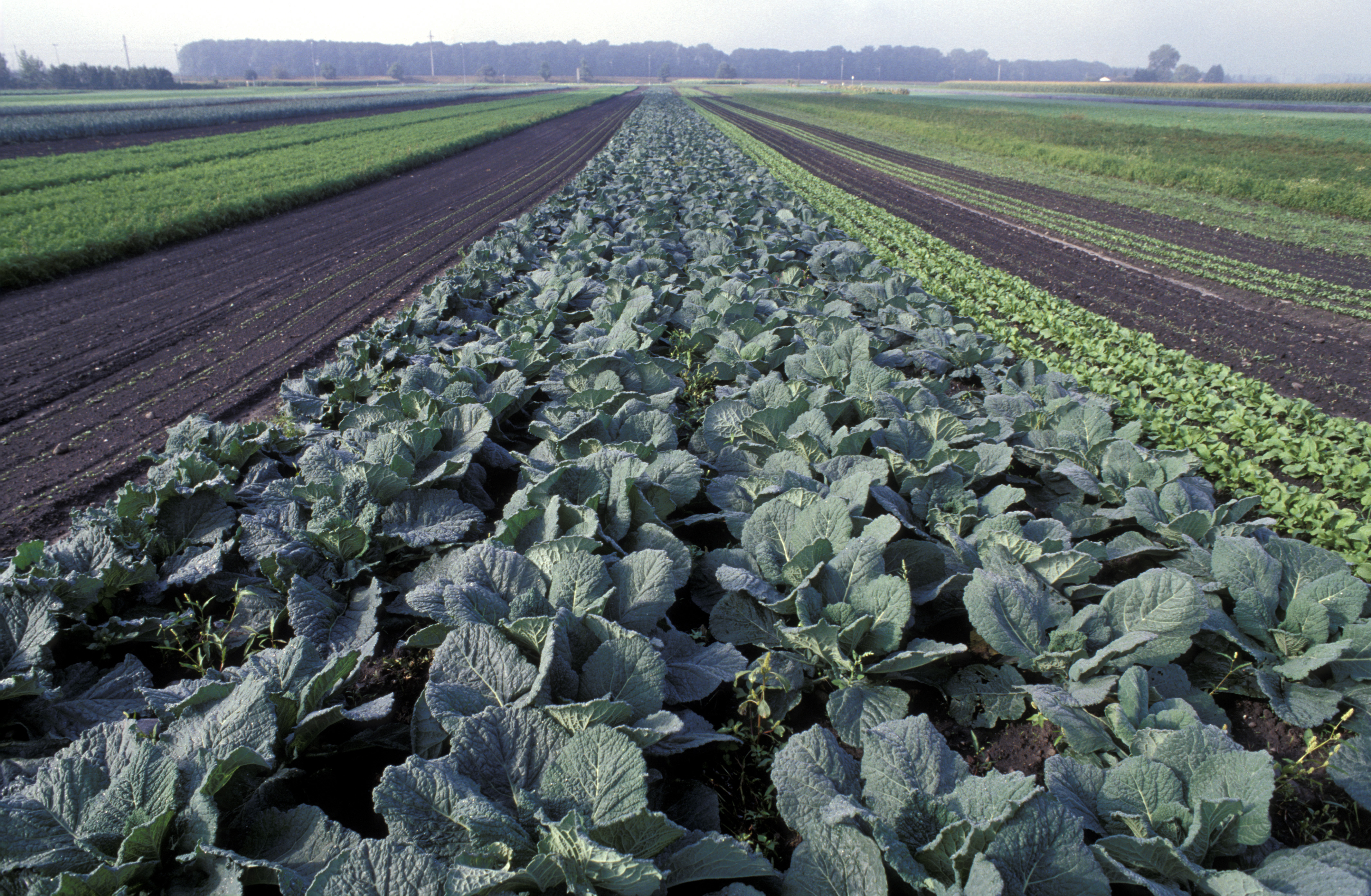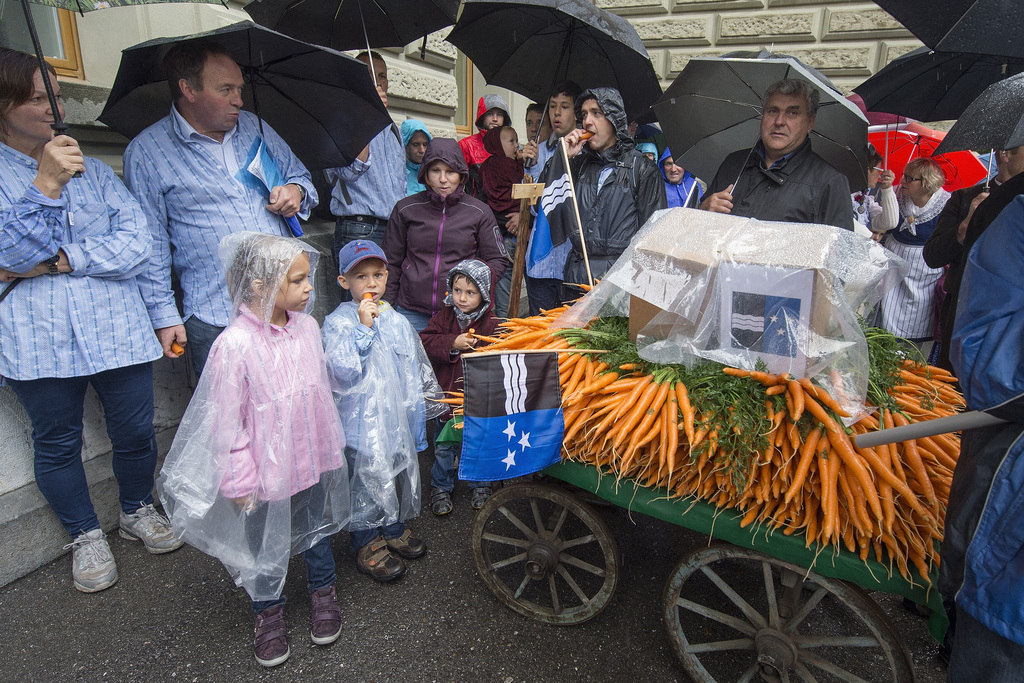Weighing up fair food and living off the land

Enough food to eat and enough to export. It’s a balancing act. In the political pipeline, three separate initiatives promoting Swiss agriculture and sustainable food are attempting to tackle the issue.
In July a group of farmers walked through the Swiss capital in a colourful procession showing off agricultural produce. They were marking having successfully collected around 150,000 signatures within a record three months for an initiative to boost the production of food.

More
Initiative aims to secure local food supply
The move by the main Farmers’ Association was not only proof of their efficient organisation but also a sign that agricultural issues are popular among citizens.
Earlier in the year the Green Party launched its own proposal focusing on improving quality standards for imported food. Its “Fair Food” initiative aimed to promote sustainable production, both in Switzerland and abroad.
For Green Party parliamentarian and organic farmer Maya Graf, it’s crucial to ensure an environmentally-friendly food supply for Switzerland and at fair conditions.
“Food is not just like any other goods that can be moved around like watches. It is a sensitive product that influences people’s lives, the environment and the climate,” she says. “And food security is important.”
And next month, a slightly different pitch is being taken by the leftwing Uniterre farmers movement.
Their proposal being launched in September wants the government to boost the supply of “healthy food from a diverse agricultural system” that covers its own costs and in line with people’s social and environmental expectations.
Self-sufficiency
Switzerland imports more than it exports and the domestic production has remained steady in recent years as the following graphic shows.
Both the initiatives by Uniterre and the Farmers’ Association focus on boosting food production in Switzerland, but without setting target figures.
Currently Switzerland’s rate of food self-sufficiency is about 64%. The net food self-sustainability rate is 56% once animal feed imports are factored in.
The rate is low when compared with other countries, according to a 2009 analysis by the United Nations Food and Agriculture Organization.
Argentina has the highest self-sufficiency rate at 273% and Norway the lowest at 50%.
The figures are to be taken with a pinch of salt, says Daniel Erdin, head of the statistics unit of the Farmers’ Association. And not only because they date back to 2009.
“The quality of the data might differ from country to country and be based on a number of estimations. Even the Swiss statistics,” he explains. A comparison of individual years is less meaningful than looking at long-term developments, such as a steady increase or a dramatic slump over a couple of decades.
Moreover , a survey on proteins and mineral substances in the food would give a different picture, Erdin continues. “The value of food is not measured in figures only. It can also give pleasure.”
No isolation
Rejecting the Farmers’ Association’s initiative, Stefan Vannoni of the Swiss Business Federation says striving for complete self-sufficiency is a delusion.
“Switzerland is not an island in agricultural terms.” Quite the contrary, he adds. Switzerland has to shore up its trade relations and improve its agricultural production.
He warns against attempts to target a maximum degree of independence notably by protective customs.
“Food sustainability can be achieved by an efficient agricultural production and good trade relations,” he says.
The value of food is not measured in figures only. It can also give pleasure.
Daniel Erdin
In a similar vein, independent agricultural expert Andreas Bosshard describes the calls for more independence as “populist”. He says time is needed to implement the latest agricultural reforms. (see: Infobox Agricultural policy)
Dialogue
Bernard Lehmann, director of the Federal Agriculture Office, has weighed into the debate about sustainability and food security.
In the July news letter of his office, he stressed the need for dialogue between those who are concerned about the ability of Swiss farmers to supply enough food in the future and the promoters of an environment-friendly production.
“The government and parliament took a clear position last year. It’s not an ‘either – or’. The agricultural sector has to find a way of keeping the natural resources which are the basis for production and ensure quality.”
“At the same time, the resources have to be used so that enough food of high quality can be produced to feed a growing population.”
He slammed outright opponents of the current agriculture policy and called for discussions to clarify details.
Looking back over the recent past, he says previous debates focused on a possible overproduction of food in industrialised countries. But the next 30 years could bring about a major change.
The demand for food worldwide will probably increase 60% by 2050 according to Lehmann.
Parliament in spring 2013 approved the latest in a series of agricultural reforms. A consolidated system of direct payments is aimed to ensure sustainability and ensure food supply. Three separate initiatives are pending at different stages of the direct democracy procedure seeking changes to the official agriculture policy.
The Farmers Association handed in the necessary number of signatures in July. It calls for measures to stop the decline in productive land and boost domestic food production.
The Green Party launched its Fair Food initiative in January and has until November 2015 to win the support of citizens in the street. Its proposal seek to set clear rules based on environmental, animal health and labour standards notably for imported food.
The Uniterre movement plans to launch its initiative in September. It aims to give priority to promoting domestic food production, more personnel and limiting imports.
The number of Swiss farms has dropped to just over 55,200 by 2013 from about 125,300 over the past 30 years. The number of employees working in agriculture has continually decreased to about 159,000 according to the Federal Statistical Office. The total farming land covered 1,05 million hectares last year, about 14% of which was arable land.

In compliance with the JTI standards
More: SWI swissinfo.ch certified by the Journalism Trust Initiative















You can find an overview of ongoing debates with our journalists here . Please join us!
If you want to start a conversation about a topic raised in this article or want to report factual errors, email us at english@swissinfo.ch.